Perhaps like many people I had some vague notions about the tale of the now extinct North American Passenger Pigeon but until this week I had never read anything substantial to make the story register in my own bird brain.
To coincide with the 100 years anniversary of the Passenger Pigeon’s extinction I set about reading the sad and tragic story as retold in a new book entitled simply enough The Passenger Pigeon, on release now from Princeton University Press.
In the Introduction the author Errol Fuller makes it clear that the book is not a scientific textbook or a species monograph but more a commemoration of the Passenger Pigeon’s former existence. He magnanimously suggests that if readers desire a more technical book they should seek out earlier works of 1907, 1955 or perhaps another published recently in early 2014, A Feathered River Across the Sky by Joel Greenberg.
While there are nine chapters to The Passenger Pigeon, not counting the Prologue, Introduction, Appendices, Acknowledgements, Further Reading and Index, the substance of the tragedy is essentially told in just four or five of the nine chapters.
“Imagine” does indeed require a leap of imagination to understand how the Passenger Pigeon was once more than common, 25 to 40% of the total bird population of the United States, their numbers estimated at between 3 and 5 billion. And no, that’s not a typo it’s a “b” for “billion”. The number of pigeons literally blackened the skies, their vast flocks a mile or more wide and hundreds of miles long. As the pigeons descended from on high their combined weight would send trees crashing to the ground, their all-consuming need destroying whole crop fields and orchards while leaving trails of destruction in their wake.
The chapters “Downward Spiral” and “Extinction” relate how the early explorers and colonists of North America were in awe and wonder of the flights of Passenger Pigeons, flights of such dimensions and numbers that the huge droves could take whole hours or even days to pass by an observer. Taking their cue from native Indians it didn’t take long for the newcomers to realise that the Passenger Pigeon was an apparently bottomless food resource and very soon pigeon meat was commercialised as cheap food for slaves and the poor in the 19th century.
There was a further reduction in numbers of pigeons from habitat loss when European settlers cleared millions of acres of forest for agriculture and townships, contributing to declines between about 1800 and 1870, and then a calamitous decline between 1870 and 1890.
Throughout the years there was also hunting on a massive scale, the combined losses from the variety of pressures resulting in the previous abundance becoming unsustainable.
As early as 1856 and as a consequence of the wholesale slaughter taking place, one Benedict Revoil dared to suggest that future ornithologists would never see Passenger Pigeons. One year later the Ohio Senate declared that the “wonderfully prolific” Passenger Pigeon “needs no protection”. Martha, thought to be the world's last Passenger Pigeon, died on September 1, 1914 at the Cincinnati Zoo.
Is it more than ironic then that the name "passenger pigeon" derives from the French word passager, which means "to pass by" in a fleeting manner? Should we excuse the human race from blame as they had little or no understanding of the concept of extinction? While the words “extinct” or “extinction” had been in figurative use from the 15th century to refer to fires, lights, or the wiping out of a material thing such as a debt, its use in reference to a species did not appear until the late 1780s.
Although there are many plates scattered throughout the book, from historic photographs, through to the reproduction of the magnificent and impressionist painting Falling Bough (2002) by Walton Ford, and to those of the masterly and revolutionary artist John James Audubon, separate chapters are devoted respectively to “Art and Books” and “Quotations”. I rather enjoyed the poignancy and compassion of these pages as an antidote to the enlightening but ultimately depressing chapters which document the pigeon’s short existence on Earth.
In these pages I discovered that the Passenger Pigeon was included in H. Meyer’s Illustrations of British Birds as a “Rare Visitant” to these shores, and what a beauty it was, somewhere between a Mourning Dove and a Turtle Dove. Whether from their numbers one or two became Atlantic blown casualties is debatable but highly likely. And now I simply can’t wait to visit downtown Cincinnati where a mural of Passenger Pigeons covers one side of a large building at the corner of Eighth and Vine Streets and where Martha herself measures twenty-one foot from beak to tail.
“Quotations” includes several graphic and meaningful descriptions of The Passenger Pigeon dating from the early 18th to the early 20th Century with just a couple quoted here:
The pigeon was known by our race as O-me-me-Wog… they naturally called it a wild pigeon, as they called us wild men - Chief Simon Pokagon
The Pigeons were still passing in undiminished numbers and continued to do so for three days in succession. The banks of the Ohio were crowded with men and boys incessantly shooting at the pilgrims….. multitudes were thus destroyed. For a week or more the population fed on no other flesh than that of Pigeons and talked of nothing but Pigeons - John James Audubon
In the Introduction the author cautioned against using the word “celebration” to describe his book. I’m sure he was correct because The Passenger Pigeon is more a fitting memorial, an honouring of a bird that was simply too successful, too available and too numerous, but never a match for the greed and stupidity of man.
Would that we never repeat the mistakes, but we invariably and inevitably do.
The Passenger Pigeon by Errol Fuller is on sale now from Princeton University Press priced at $29.95 or £ 19.95.









































.jpeg)












.jpg)












